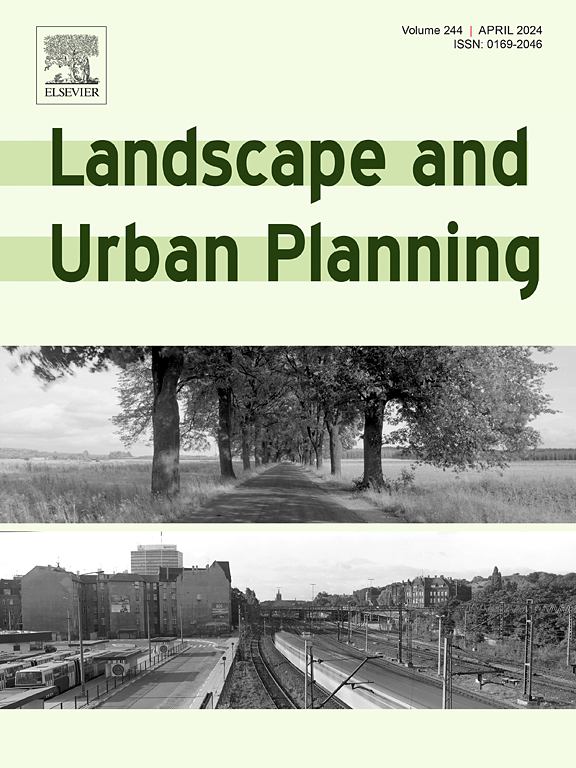绿地暴露对社区居住老年人急性呼吸系统疾病的影响:一项前瞻性队列研究
IF 7.9
1区 环境科学与生态学
Q1 ECOLOGY
引用次数: 0
摘要
很少有研究调查了个人日常活动中接触绿地对呼吸系统健康的影响。本研究旨在评估老年人在住宅附近和户外活动期间接触绿色空间如何影响急性呼吸道疾病(ARI)的发病率。方法从香港社区老年人前瞻性队列中招募参与者,随访两年以监测ARI的发生情况。使用GPS手表,我们连续七天跟踪参与者的活动,收集他们每天的路径数据。采用时间加权空间平均法(TWAM),结合总绿地及其亚型的有无、归一化植被指数(NDVI)、冠层覆盖度和植物面积指数(PAI)等指标,计算日均绿地暴露量。广义线性混合效应模型分析了这些暴露与温暖季节和寒冷季节ARI发病率之间的关系,限制三次样条模型研究了剂量-反应关系。结果在134名参与者(平均年龄76.2岁,82.8%为女性)中,调整混杂因素后,观察到在室外暴露于树冠覆盖物(优势比0.36,95%置信区间0.14,0.88)和PAI(优势比0.38,95%置信区间0.17,0.84)对ARI有显著的保护作用。在暖、冷季节,除草地外,总绿地面积及其亚类与ARI均呈负相关。未观察到与NDVI有显著关系。绿地暴露与急性呼吸道感染发病率之间的保护关系表现出剂量-反应模式,在活动模式下更为明显。没有住宅绿地暴露与急性呼吸道感染风险显著相关。结论:在城市地区的老年人中,增加户外绿地暴露与降低ARI风险有关。这些发现强调了在绿色环境中进行户外活动对呼吸系统健康的潜在益处。本文章由计算机程序翻译,如有差异,请以英文原文为准。

Effects of green space exposure on acute respiratory illness in community-dwelling older people: A prospective cohort study
Background
Few studies have investigated the effects of green space exposure during individuals’ daily activities on respiratory health. This study aims to evaluate how exposure to green space both within residential vicinities and during out-of-home activities influences the incidence of acute respiratory illness (ARI) among older adults.
Methods
Participants were recruited from a prospective cohort of community-dwelling older people in Hong Kong, who were followed for two years to monitor the occurrence of ARI. Using GPS watches, we tracked participants’ movements for seven consecutive days to gather data on their daily paths. The time-weighted spatial averaging method (TWAM) was used to calculate daily exposure to green space, incorporating metrics such as the presence or absence of total green space and its subtypes, the normalized difference vegetation index (NDVI), canopy cover, and plant area index (PAI). Generalized linear mixed-effects models analyzed the association between these exposures and ARI incidence across warm and cool seasons, with restricted cubic spline models examining dose–response relationships.
Results
Among the 134 participants (average age 76.2 years, 82.8 % female), after adjusting confounders, significant protective effects against ARI were observed with increased exposure to canopy cover (odds ratio 0.36, 95 % confidence interval 0.14, 0.88) and PAI (odds ratio 0.38, 95 % confidence interval 0.17, 0.84) outside the home. In warm or cool seasons, total green space and its subcategories also had an inverse relationship with ARI, except for grassland. No significant relationships were observed with NDVI. The protective relationship between green space exposure and ARI incidence demonstrated a dose–response pattern, more pronounced in active mode. No residential green space exposures were significantly associated with ARI risk.
Conclusions
Increased green space exposure outside the home is associated with a reduced risk of ARI among older adults living in urban areas. These findings highlight the potential health benefits of engaging in outdoor activities within green environments for respiratory health.
求助全文
通过发布文献求助,成功后即可免费获取论文全文。
去求助
来源期刊

Landscape and Urban Planning
环境科学-生态学
CiteScore
15.20
自引率
6.60%
发文量
232
审稿时长
6 months
期刊介绍:
Landscape and Urban Planning is an international journal that aims to enhance our understanding of landscapes and promote sustainable solutions for landscape change. The journal focuses on landscapes as complex social-ecological systems that encompass various spatial and temporal dimensions. These landscapes possess aesthetic, natural, and cultural qualities that are valued by individuals in different ways, leading to actions that alter the landscape. With increasing urbanization and the need for ecological and cultural sensitivity at various scales, a multidisciplinary approach is necessary to comprehend and align social and ecological values for landscape sustainability. The journal believes that combining landscape science with planning and design can yield positive outcomes for both people and nature.
 求助内容:
求助内容: 应助结果提醒方式:
应助结果提醒方式:


